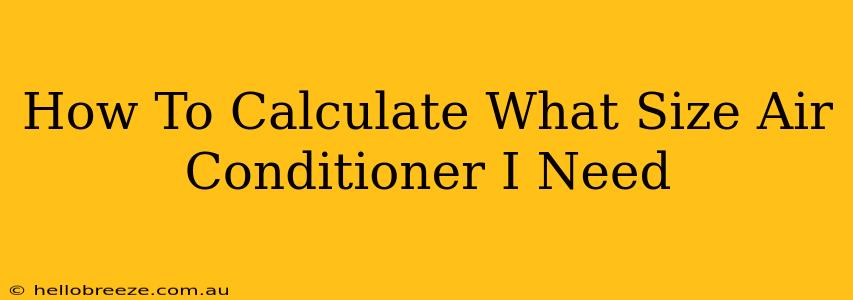Choosing the right air conditioner can be tricky. An undersized unit will struggle to cool your space, leading to high energy bills and discomfort. Conversely, an oversized unit will cycle on and off frequently, costing more and failing to dehumidify properly. This guide will walk you through calculating the correct air conditioner size for your needs.
Understanding BTU Ratings
The key to sizing your AC correctly lies in understanding BTUs (British Thermal Units). A BTU represents the amount of heat energy required to raise the temperature of one pound of water by one degree Fahrenheit. Air conditioners are rated by their cooling capacity in BTUs per hour (BTU/hr). A higher BTU rating indicates a more powerful unit.
Factors Affecting BTU Needs:
Several factors influence the BTU requirements for your space:
- Room Size: Larger rooms naturally require more cooling power. You'll need to calculate the square footage of the room you intend to cool.
- Climate: Hotter climates demand higher BTU ratings. Consider the average summer temperatures in your region.
- Insulation: Well-insulated rooms retain coolness better, reducing the BTU needs. Poor insulation necessitates a larger unit.
- Number of Windows and Doors: More windows and doors mean more opportunities for heat to enter, increasing the BTU requirement. Consider window size and direction (south-facing windows receive more direct sunlight).
- Ceiling Height: Higher ceilings require more cooling power than standard 8-foot ceilings.
- Number of People and Appliances: People and appliances (computers, televisions, etc.) generate heat, increasing the BTU requirement.
- Sunlight Exposure: Rooms with extensive sunlight exposure will require a higher BTU rating than those with minimal exposure.
Calculating Your BTU Needs:
While several online calculators exist, a general guideline is to calculate your BTU needs based on square footage. However, remember that this is just an estimate, and professional consultation is always recommended.
Simplified Calculation: A rough estimate is 20 BTUs per square foot. So, for a 200 square foot room, you might need a 4000 BTU air conditioner (200 sq ft * 20 BTU/sq ft = 4000 BTU).
More Accurate Calculation: For a more accurate calculation, you'll need to consider all the factors listed above. Several online calculators use more complex formulas to give you a more precise BTU recommendation. Simply search "air conditioner BTU calculator" online.
Choosing the Right Air Conditioner Type:
Once you've estimated your BTU needs, you'll need to select the right type of air conditioner. Consider the following:
- Window Air Conditioners: Best for single rooms, simple installation.
- Portable Air Conditioners: Versatile, can be moved from room to room, but less efficient than window units.
- Central Air Conditioners: Best for whole-house cooling, professional installation required.
- Ductless Mini-Splits: Highly efficient, zoned cooling, more expensive than window or portable units.
Beyond BTU: Other Important Considerations
Don't solely focus on BTUs. Pay attention to:
- Energy Efficiency (SEER Rating): The Seasonal Energy Efficiency Ratio (SEER) measures how much cooling you get per watt of electricity. A higher SEER rating indicates greater energy efficiency.
- Noise Level: Consider the decibel rating, particularly if the unit will be in a bedroom or quiet space.
- Features: Consider features like programmable timers, multiple fan speeds, and dehumidification capabilities.
Professional Advice:
While this guide provides helpful information, it’s crucial to consult with a qualified HVAC professional for a precise assessment of your cooling needs. They can take into account the specific characteristics of your home and recommend the most appropriate air conditioning system. Getting professional help ensures you choose the right unit for optimal comfort and energy efficiency. This ultimately saves you money and ensures your comfort.

